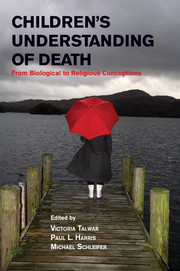Book contents
- Frontmatter
- Contents
- List of Figures and Table
- List of Contributors
- Preface and Acknowledgments
- 1 Death, Ancestors, and the Living Dead: Learning without Teaching in Madagascar
- 2 Death in Spain, Madagascar, and Beyond
- 3 Ambivalent Teaching and Painful Learning: Mastering the Facts of Life (?)
- 4 Death in the Lives of Children
- 5 Talking to Children about Death in Educational Settings
- 6 Responsible Believing
- 7 Thoughts and Feelings: Children and William James Have It Right!
- 8 How the Law Constructs Its Understanding of Death
- Index
- References
8 - How the Law Constructs Its Understanding of Death
Published online by Cambridge University Press: 03 May 2011
- Frontmatter
- Contents
- List of Figures and Table
- List of Contributors
- Preface and Acknowledgments
- 1 Death, Ancestors, and the Living Dead: Learning without Teaching in Madagascar
- 2 Death in Spain, Madagascar, and Beyond
- 3 Ambivalent Teaching and Painful Learning: Mastering the Facts of Life (?)
- 4 Death in the Lives of Children
- 5 Talking to Children about Death in Educational Settings
- 6 Responsible Believing
- 7 Thoughts and Feelings: Children and William James Have It Right!
- 8 How the Law Constructs Its Understanding of Death
- Index
- References
Summary
We often think of the law as something that operates outside of daily life, only affecting us when we engage in commerce or conduct that constitutes the most egregious transgressions. This is particularly true in a place like the United States, where the legal system is intentionally drawn to preserve personal autonomy. For example, there are few rules regarding personal decisions as how to dress, and individual liberties are protected by a constitutional right of privacy. Nonetheless, in all societies the law plays a vital role in shaping norms, and a study of its rules can provide insight to our most fundamental beliefs about the world. Nowhere is this more true than in the rules governing death. These rules serve as a reflection of both our metaphysical beliefs about the nature of death as well as our values about the proper relationship between the living and the dead – including what, if anything, the dead owe the living and what the living owe the dead. Moreover, the law acts as part of a feedback mechanism. Legal rules are based on people's beliefs about the world, and then the rules themselves provide their own norms, which in turn shape people's beliefs about the world.
- Type
- Chapter
- Information
- Children's Understanding of DeathFrom Biological to Religious Conceptions, pp. 156 - 186Publisher: Cambridge University PressPrint publication year: 2011



